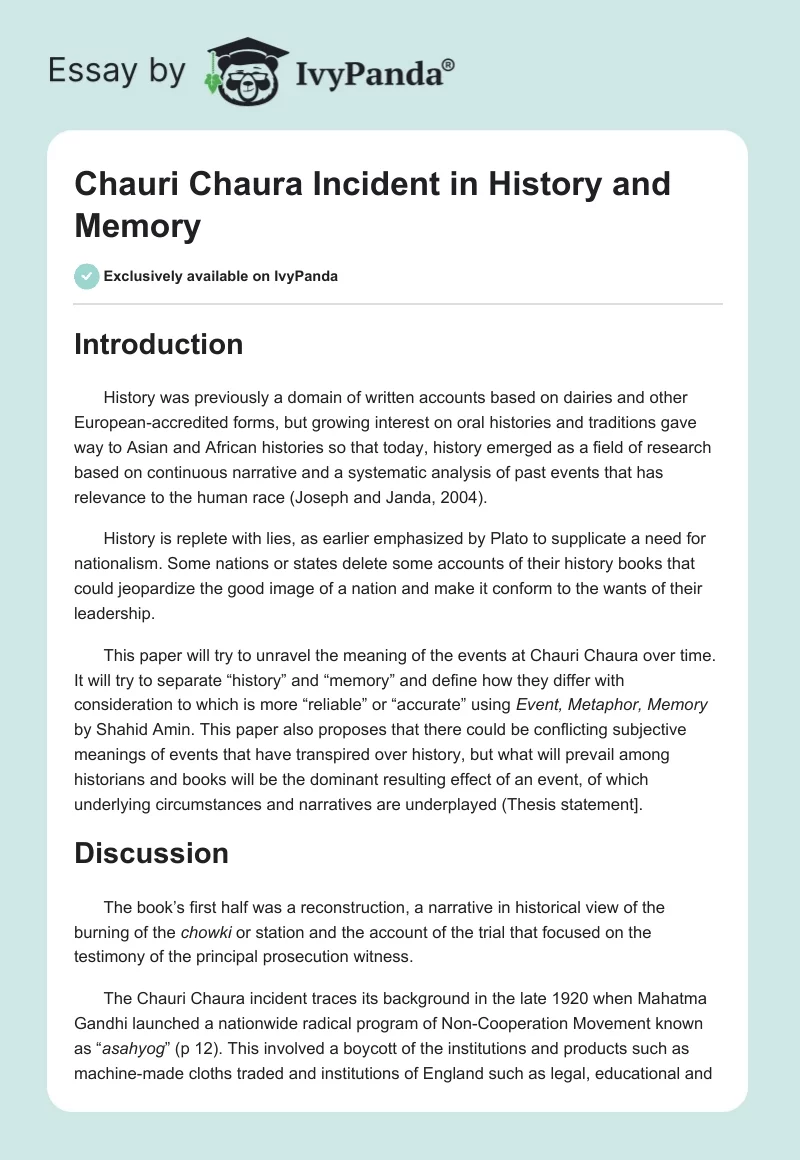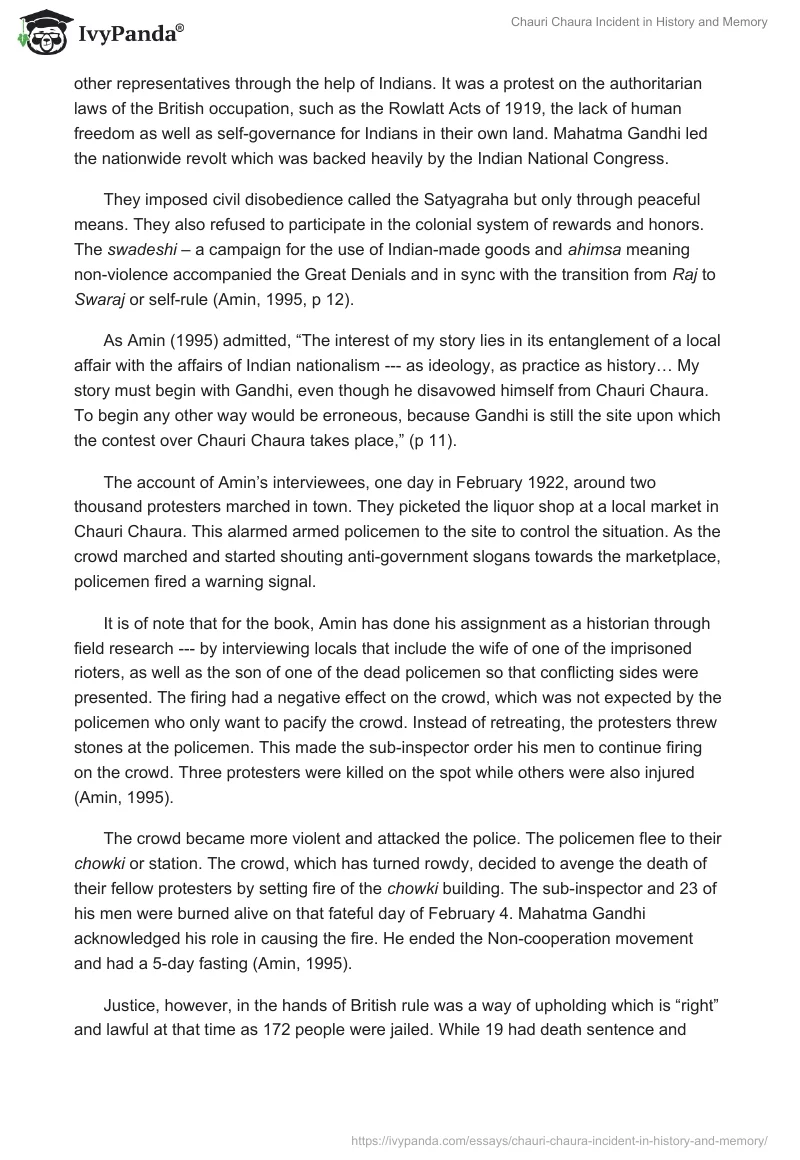Introduction
History was previously a domain of written accounts based on dairies and other European-accredited forms, but growing interest on oral histories and traditions gave way to Asian and African histories so that today, history emerged as a field of research based on continuous narrative and a systematic analysis of past events that has relevance to the human race (Joseph and Janda, 2004).
History is replete with lies, as earlier emphasized by Plato to supplicate a need for nationalism. Some nations or states delete some accounts of their history books that could jeopardize the good image of a nation and make it conform to the wants of their leadership.
This paper will try to unravel the meaning of the events at Chauri Chaura over time. It will try to separate “history” and “memory” and define how they differ with consideration to which is more “reliable” or “accurate” using Event, Metaphor, Memory by Shahid Amin. This paper also proposes that there could be conflicting subjective meanings of events that have transpired over history, but what will prevail among historians and books will be the dominant resulting effect of an event, of which underlying circumstances and narratives are underplayed (Thesis statement].
Discussion
The book’s first half was a reconstruction, a narrative in historical view of the burning of the chowki or station and the account of the trial that focused on the testimony of the principal prosecution witness.
The Chauri Chaura incident traces its background in the late 1920 when Mahatma Gandhi launched a nationwide radical program of Non-Cooperation Movement known as “asahyog” (p 12). This involved a boycott of the institutions and products such as machine-made cloths traded and institutions of England such as legal, educational and other representatives through the help of Indians. It was a protest on the authoritarian laws of the British occupation, such as the Rowlatt Acts of 1919, the lack of human freedom as well as self-governance for Indians in their own land. Mahatma Gandhi led the nationwide revolt which was backed heavily by the Indian National Congress.
They imposed civil disobedience called the Satyagraha but only through peaceful means. They also refused to participate in the colonial system of rewards and honors. The swadeshi – a campaign for the use of Indian-made goods and ahimsa meaning non-violence accompanied the Great Denials and in sync with the transition from Raj to Swaraj or self-rule (Amin, 1995, p 12).
As Amin (1995) admitted, “The interest of my story lies in its entanglement of a local affair with the affairs of Indian nationalism — as ideology, as practice as history… My story must begin with Gandhi, even though he disavowed himself from Chauri Chaura. To begin any other way would be erroneous, because Gandhi is still the site upon which the contest over Chauri Chaura takes place,” (p 11).
The account of Amin’s interviewees, one day in February 1922, around two thousand protesters marched in town. They picketed the liquor shop at a local market in Chauri Chaura. This alarmed armed policemen to the site to control the situation. As the crowd marched and started shouting anti-government slogans towards the marketplace, policemen fired a warning signal.
It is of note that for the book, Amin has done his assignment as a historian through field research — by interviewing locals that include the wife of one of the imprisoned rioters, as well as the son of one of the dead policemen so that conflicting sides were presented. The firing had a negative effect on the crowd, which was not expected by the policemen who only want to pacify the crowd. Instead of retreating, the protesters threw stones at the policemen. This made the sub-inspector order his men to continue firing on the crowd. Three protesters were killed on the spot while others were also injured (Amin, 1995).
The crowd became more violent and attacked the police. The policemen flee to their chowki or station. The crowd, which has turned rowdy, decided to avenge the death of their fellow protesters by setting fire of the chowki building. The sub-inspector and 23 of his men were burned alive on that fateful day of February 4. Mahatma Gandhi acknowledged his role in causing the fire. He ended the Non-cooperation movement and had a 5-day fasting (Amin, 1995).
Justice, however, in the hands of British rule was a way of upholding which is “right” and lawful at that time as 172 people were jailed. While 19 had death sentence and others imprisoned from 2 years jail to a lifetime, 38 were also acquitted, and 3 accused died during the trial.
Already, modern history already provided its own view of the Chauri Chaura incident. It was considered of less relevance and that it did not interrupt a nation’s demand for political freedom. It was regarded as regrettable. Subsequently, this has been reduced to a riot around 1922, involving Mahatma Gandhi, struggles of a nation, death of a number of policemen, Gandhi’s torment, the suspension of a nationwide movement due to the local violence.
Accordingly, what Babu Rajendra Prasad was seen by Amin (1995, p 10) as “awkward sentence … illustrates the manner in which ‘Chauri Chaura’ was later recollected in nationalist historiography: “In the month of February, serious riots took place at a place called Chauri Chaura, in the district of Gorakhpur, and Mahatma Gandhi who had proceeded to Bardoli to lead a campaign if mass Civil Disobedience and had gone so far as to issue his message to the Viceroy and Government intimating his intention of mass Civil Disobedience had to suspend the campaign as a consequence.”.
Amin has added (p 10), “…how ill this necessary footnote within Indian history has fared at the hands of professional historians and nationalist Indians. The former have sometimes even got the date wrong, and there has been some understandable confusion about an exact number of policemen killed… When historical significance is attached to an occurrence independent of an event, the facts of the case cease to matter. And where all subsequent accounts are parasitic on a prior memory, documentation seems almost unnecessary.”
One review (Fuller, 1998), found the book with two meanings: for the Gandhi group, an outrage that caused the immediate abortion of the Non-Cooperation Movement that undermined the nationalist campaign, and for a later period, a “legitimate episode in the history of the ‘freedom struggle’” (p 388) as those 172 who were sentenced to death and the burnt policemen became martyrs. Consequently, Amin meant “to rescue Chauri Chaura and its protagonists from these hegemonic and distortive narratives, so that the subalterns’ individual actions and voices can be restored.” (p 389).
Conclusion
According to Amin, he tried to “generate an entirely alternative narrative of the event… The subalterns make their own memories, but they do not make them as they please,” (p 118). This may mean that while memories may be subjective at most, and less reliable than researched material which consists of history, memories cannot be removed from history as historians may wish.
There is an implied bigger role of a historian as narrator of events and accounts, factual or mythical, but this does not give the historical and all-out authority to diminish what was preserved as actual accounts in the minds of individuals such as those who were part of the Chauri Chaura event.
Today, the Chauri Chaura in a more nationalist view related to the call of Gandhi in Non-cooperation movement, with deeper meanings for history itself: Amin argued that the reason the peasants acted that way in February 1922 in Gorakhpur was no different from other nation’s uprising of the masses. And that not because the hero that is Mahatma Gandhi turned his back on the rioters, did not lessen the role they have played, the fire they have ignited, and the nationalism they have exemplified. Amin (1995) wrote, “Chauri Chaura became ‘Chauri Chaura’: the event, with all its distinctiveness and specificity and multiple peculiarities, was written out as it was recounted,” (p 9). Chauri Chaura’s dominant resulting effect as history provided was the freedom of a nation, and that is what counts most.
Reference
Amin, Shahid (1995). Event, Metaphor, Memory: Chauri Chaura, 1922-1992. Berkeley: University of California Press.
Fuller, C.J. (1998) Untitled. The Journal of Royal Anthropological Institute, 4 (2), pp 388-389.
Joseph, Brian (Ed.) & Janda, Richard (Ed.) (2004), The Handbook of Historical Linguistics, Blackwell Publishing.


